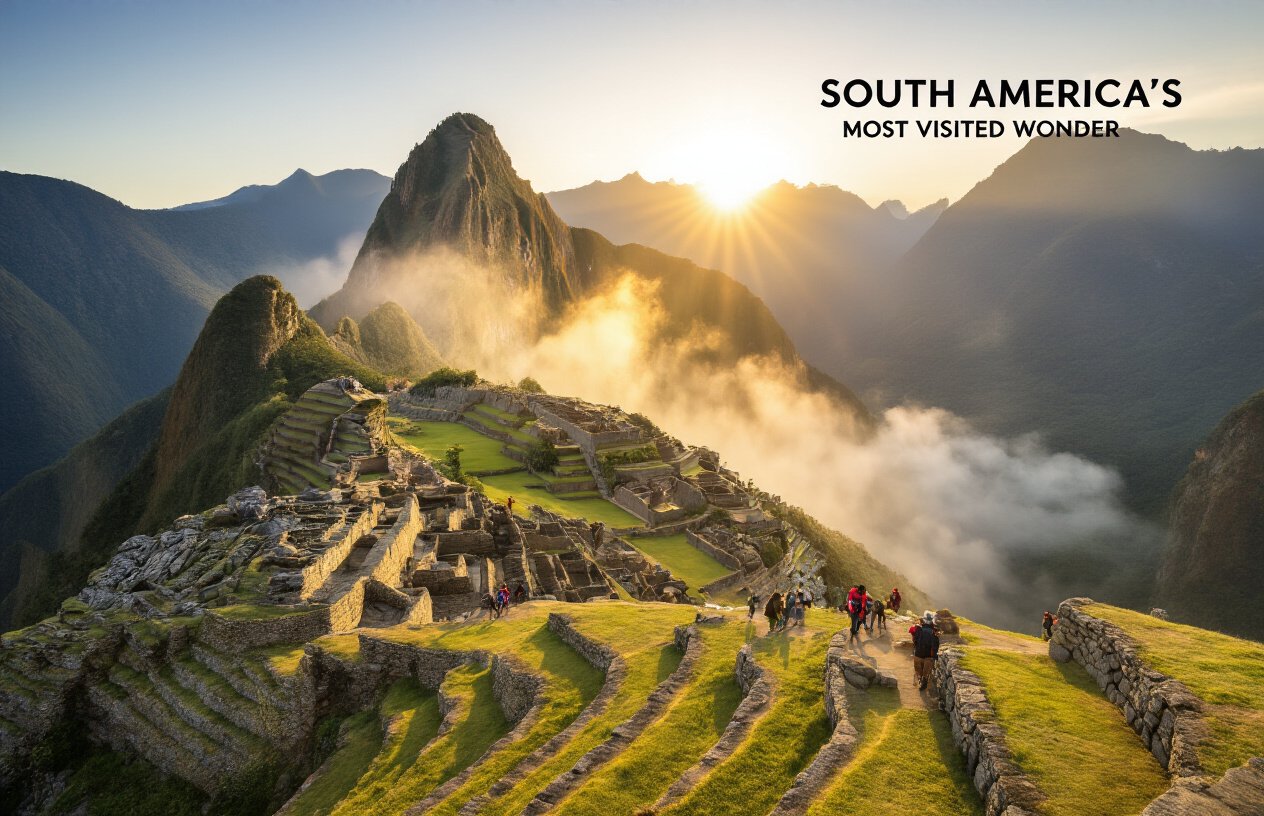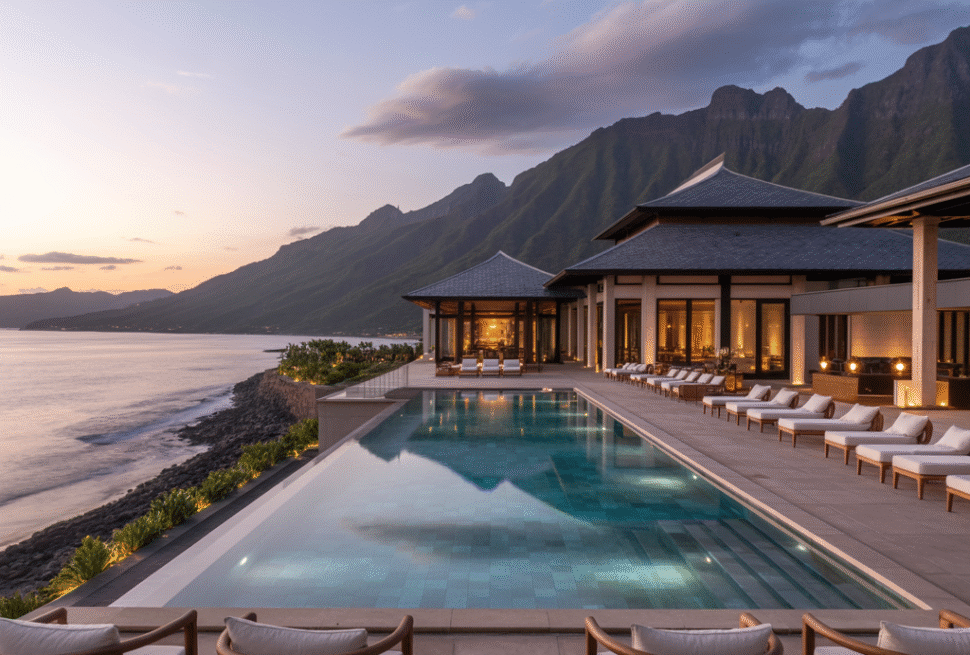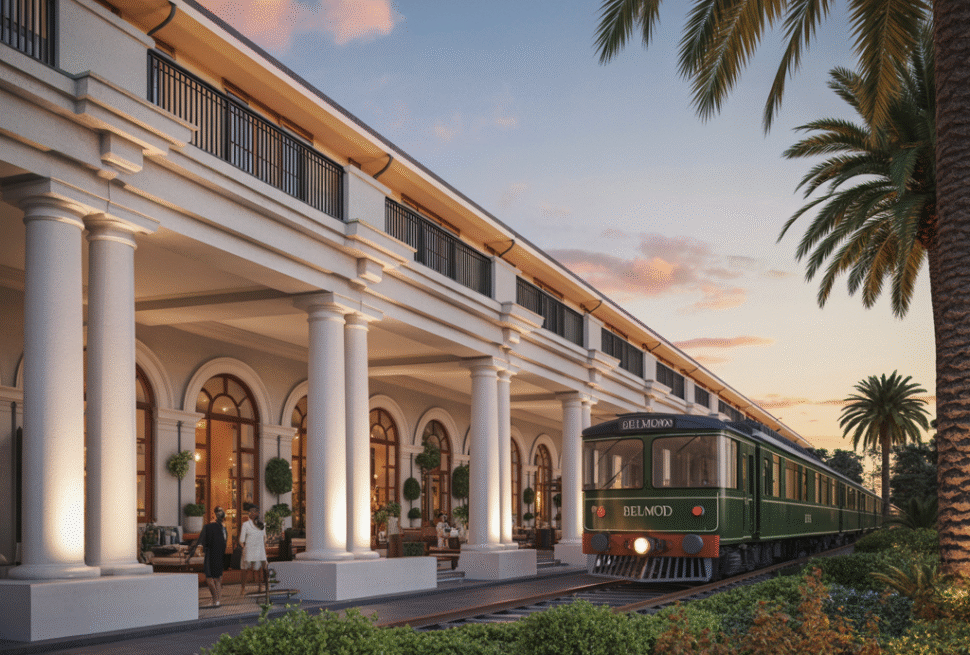Ever stood at the summit of Machu Picchu with 4,000 other tourists all jostling for that perfect Instagram shot? You’re not alone. When it comes to the most visited place in South America, this ancient Incan citadel takes the crown, welcoming over 1.5 million visitors annually.
The continent’s tourism landscape is a fascinating mix of archaeological wonders, natural marvels, and vibrant urban centers. But what makes certain destinations rise above others in popularity?
Between Brazil’s iconic Christ the Redeemer, Argentina’s thundering Iguazu Falls, and Peru’s mysterious Machu Picchu, one destination consistently draws the biggest crowds. And the reasons why might surprise even seasoned travelers.
Top Tourist Destinations in South America
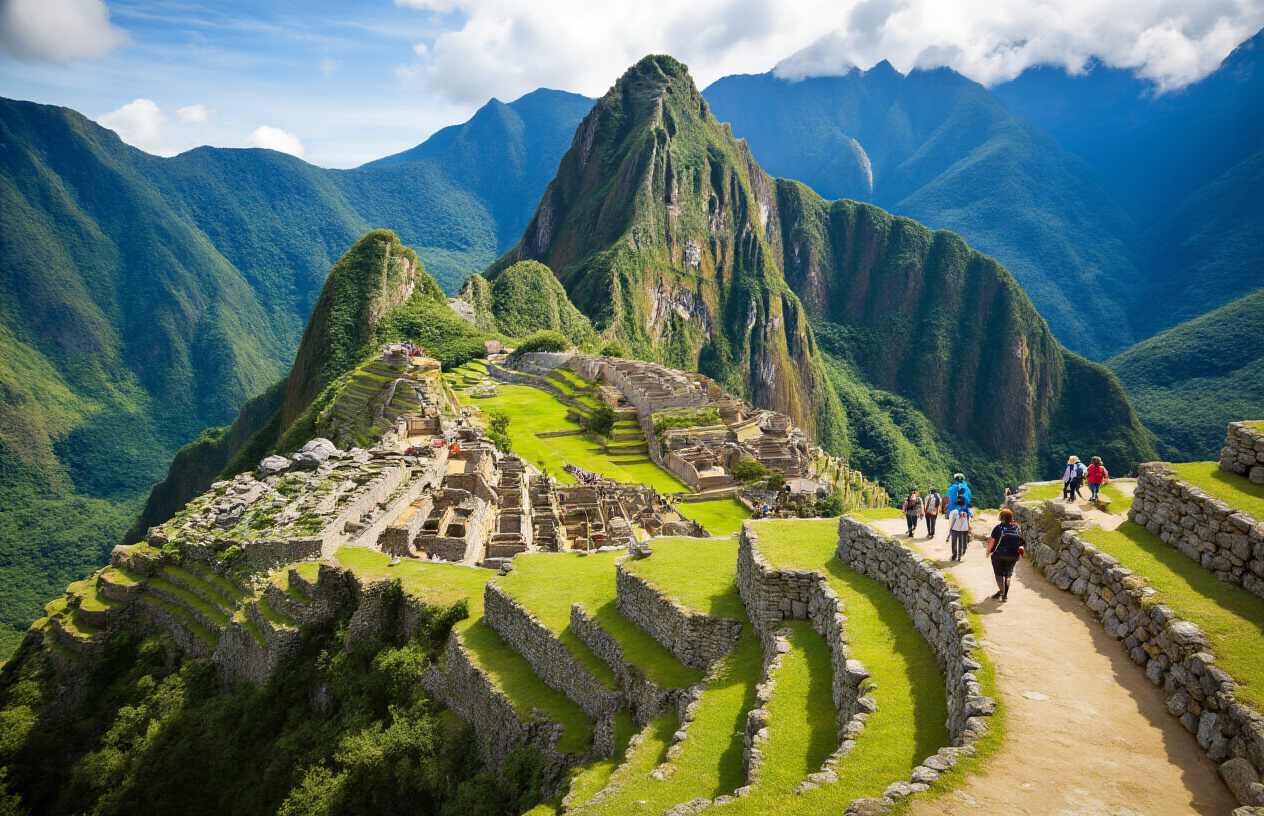
Machu Picchu: Peru’s Ancient Wonder
Wondering why Machu Picchu tops nearly every South America bucket list? Simple – nothing quite prepares you for that first glimpse of this 15th-century Inca citadel perched dramatically between two mountain peaks.
Over 1.5 million visitors make the journey annually, making it South America’s most visited archaeological site. And honestly, the photos don’t do it justice.
The journey there is half the adventure. Whether you’re hiking the legendary Inca Trail (book months in advance!) or taking the scenic train ride from Cusco, you’ll pass through cloud forests and stunning mountain scenery.
Morning visits offer the magical experience of watching the sun rise over the ancient stones, while the stonework itself will leave you scratching your head – how did they fit these massive blocks so perfectly without mortar?
Christ the Redeemer: Brazil’s Iconic Statue
Arms spread wide over Rio de Janeiro, this 98-foot Art Deco statue welcomes nearly 2 million visitors yearly. Standing atop Corcovado Mountain, it’s not just a religious symbol but Brazil’s calling card to the world.
The views? Absolutely insane. On clear days, you can see the entire city sprawled below – Sugarloaf Mountain, Copacabana Beach, and the vast Atlantic Ocean beyond.
Pro tip: Skip the crowded afternoons and go early morning or late afternoon. The changing light makes for incredible photos, and you’ll actually have space to breathe.
Iguazu Falls: Natural Beauty at the Border
Picture 275 individual waterfalls spanning nearly 2 miles across the Argentina-Brazil border. That’s Iguazu Falls – a thundering spectacle that makes Niagara look like a kitchen faucet.
Over 1.2 million visitors come to witness this natural wonder annually. The Brazilian side offers panoramic views, while Argentina’s network of walkways gets you close enough to feel the spray on your face.
Amazon Rainforest: World’s Largest Jungle
Covering nine countries but mostly Brazil, the Amazon draws adventure seekers by the thousands. This isn’t just a forest – it’s half of the world’s remaining rainforest and home to one in ten known species on Earth.
Most visitors explore from gateway cities like Manaus, taking guided boat tours through flooded forests and spotting pink river dolphins, sloths, and countless bird species. The more adventurous can arrange multi-day stays with indigenous communities.
Machu Picchu: South America’s Most Visited Attraction
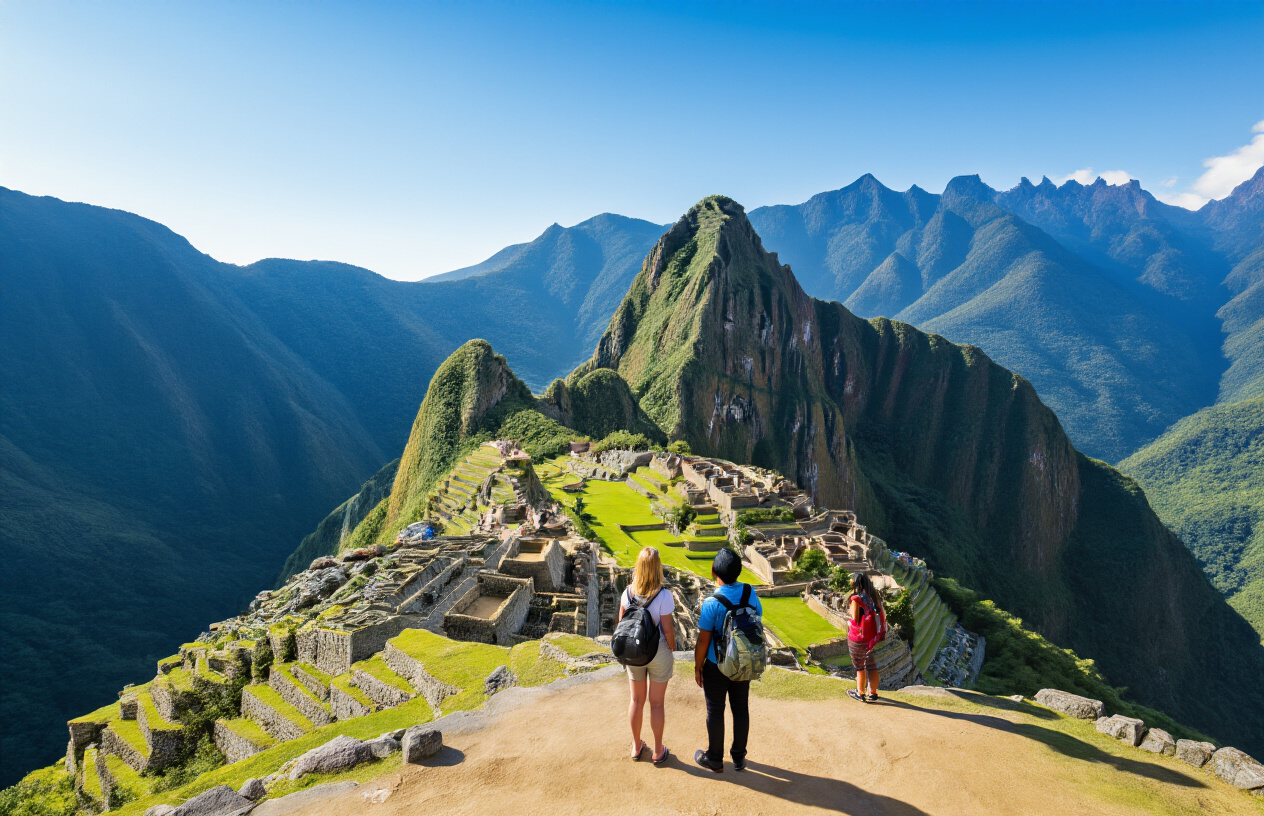
A. Historical Significance of the Incan Citadel
Ever wondered why Machu Picchu tops every South American bucket list? Built around 1450 CE as a royal estate for Emperor Pachacuti, this stone marvel wasn’t just another Incan building project – it was architectural genius that’s still baffling experts today.
The Spanish conquistadors never found it. Think about that. While they were busy dismantling other Incan treasures, Machu Picchu sat hidden, hugged by clouds and jungle for 400 years until Hiram Bingham “discovered” it in 1911 (though local farmers knew about it all along).
What makes it truly special isn’t just the stunning stone masonry that fits together without mortar – it’s the location. Perched at 7,970 feet above sea level between two mountain peaks, it’s precisely aligned with astronomical events. The Incas weren’t just good builders; they were masterful astronomers and engineers.
B. Annual Visitor Statistics and Tourism Impact
The numbers are mind-boggling. Before COVID hit, Machu Picchu welcomed nearly 1.6 million visitors annually. That’s about 4,500 people daily climbing those ancient steps!
Tourism brings roughly $570 million into Peru’s economy each year, with Machu Picchu as the crown jewel. The site single-handedly transformed Cusco from a sleepy regional city into a thriving tourist hub.
But there’s a flip side to this popularity:
| Impact Area | Effect of Tourism |
|---|---|
| Local Economy | 11,000+ jobs created |
| Infrastructure | Accelerated development |
| Environment | Soil erosion, waste management challenges |
| Cultural Integrity | Commercialization of sacred spaces |
C. Best Times to Visit Without the Crowds
Want to avoid the selfie stick forest? Timing is everything.
Most tourists flood in during the dry season (June-August). Instead, try the shoulder months – April, May, September, or October. You’ll get decent weather without the peak crowds.
For the real magic, show up at opening time (6 AM) or in the late afternoon when day-trippers have left. That golden hour light on the ancient stones? Completely different experience.
Pro tip: Tuesdays, Wednesdays, and Thursdays typically see fewer visitors year-round. And booking the last entry time (around 2 PM) lets you stay until closing when the place empties out.
D. Conservation Efforts and Visitor Limitations
Machu Picchu was literally being loved to death. The footsteps of millions were eroding pathways, damaging structures, and threatening the entire site.
In 2019, Peru finally said “enough” and implemented strict visitor caps:
- Maximum 2,500 visitors daily (down from 5,000+)
- Timed entry tickets with 4-hour visit limits
- Mandatory professional guides
- Strict prohibitions against touching structures
These measures weren’t popular with tour operators, but they were necessary. UNESCO had threatened to place Machu Picchu on its endangered list if Peru didn’t act.
Recent restoration work includes stabilizing terraces, reinforcing walls, and implementing high-tech monitoring systems that track even the slightest shifts in the ancient stones.
E. Virtual Tour Options for Remote Exploration
Can’t make the trek to Peru? Technology’s got you covered.
Several amazing virtual options now exist that go beyond simple photos:
- Google’s Street View special collection lets you “walk” the ruins
- YouVisit’s 360° tour includes expert narration at key points
- The Smithsonian offers a detailed 3D model exploring construction techniques
- Peru’s Ministry of Culture launched an AR app that reconstructs how buildings originally looked
While nothing beats standing there in person with the Andean breeze on your face, these virtual options offer incredible detail – sometimes revealing aspects you might miss in person due to crowd restrictions or time limitations.
Other Popular South American Destinations
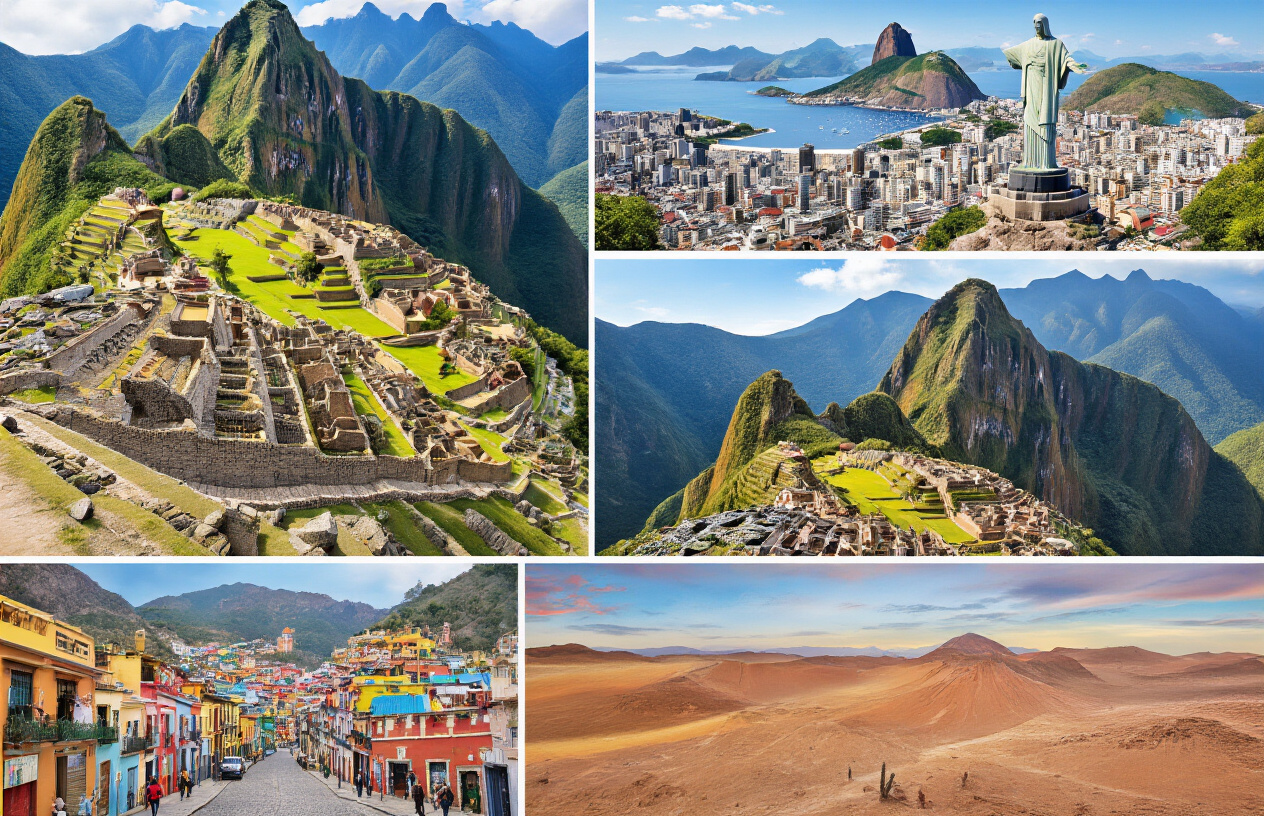
A. Rio de Janeiro’s Famous Beaches and Landmarks
While Machu Picchu might steal the South American spotlight, Rio de Janeiro gives it a run for its money. The beaches here aren’t just beaches – they’re cultural institutions. Copacabana and Ipanema aren’t just stretches of sand; they’re where life happens.
And then there’s Christ the Redeemer. This 98-foot statue doesn’t just tower over Rio – it’s practically the poster child for Brazil. Standing at the peak of Corcovado Mountain, it draws around 2 million visitors yearly who brave the crowds for that iconic selfie with arms outstretched.
Don’t skip Sugarloaf Mountain either. The cable car ride up offers views that’ll make your Instagram followers jealous for weeks.
B. Buenos Aires: Cultural Capital of Argentina
Buenos Aires hits different. It’s like someone dropped a European city in South America and added extra flavor. The streets of San Telmo pulse with tango dancers, while the colorful houses of La Boca make you feel like you’re walking through a painting.
Food lovers, prepare yourselves. The steaks here will ruin you for life. And the café culture? Pure magic. Locals spend hours in historic cafés like Café Tortoni, discussing everything from politics to fútbol over multiple cortados.
C. Galapagos Islands: Ecuador’s Natural Laboratory
Darwin wasn’t exaggerating. The Galapagos Islands feel like another planet. Where else can you swim with sea lions, watch giant tortoises roam freely, and step over blue-footed boobies that couldn’t care less about your presence?
Each island offers something unique – from the volcanic landscapes of Bartolomé to the flamingo lagoons of Floreana. Yes, it’s expensive to visit. Yes, there are strict visitor limits. But honestly? It’s worth every penny and every planning headache.
D. Lake Titicaca: Highest Navigable Lake in the World
Straddling Peru and Bolivia at over 12,500 feet above sea level, Lake Titicaca isn’t just a pretty face. The floating islands of Uros will blow your mind – entire communities living on islands made of reeds that they’ve woven by hand.
Then there’s Isla del Sol, believed by the Incas to be the birthplace of their sun god. The terraced hills, ancient ruins, and complete absence of vehicles make it feel like you’ve stepped back in time.
15 Day South America Tour encompassing Rio de Janeiro, Amazon, Foz do Iguaçu & Buenos Aires
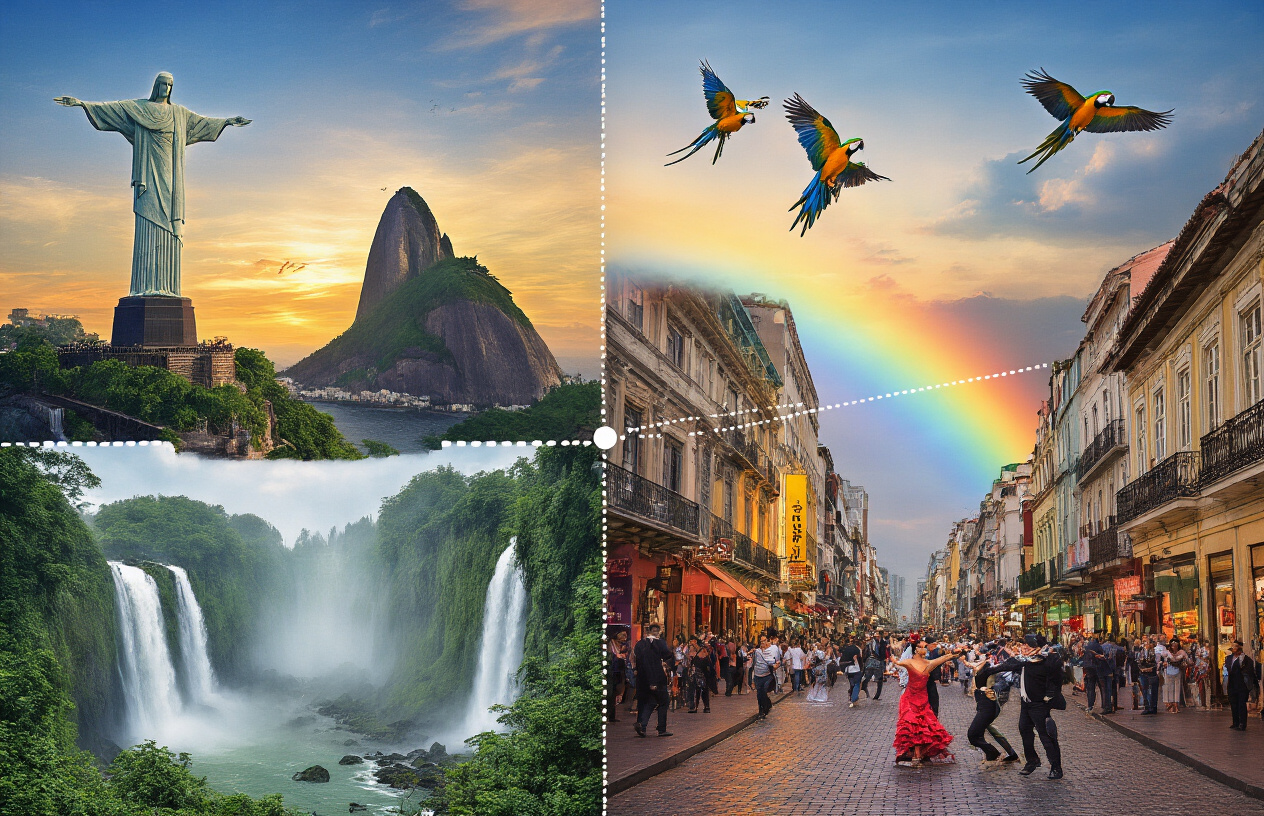
Experience the Best of South America in 15 Days
Looking for the ultimate South American adventure? This 15-day tour hits all the must-see spots in one incredible journey.
Start in Rio de Janeiro where you’ll soak up the sun on Copacabana Beach, snap photos from Christ the Redeemer, and dance the night away in Lapa. The energy here is unmatched – Cariocas (locals) know how to live it up!
Next, plunge into the Amazon rainforest where you’ll sleep in eco-lodges, spot pink dolphins, and maybe even catch a glimpse of elusive jaguars. Your guide will show you medicinal plants that indigenous people have used for centuries. The night sounds of the jungle will stay with you forever.
Then it’s off to Foz do Iguaçu, home to the jaw-dropping Iguazu Falls. Trust me, pictures don’t do it justice. You’ll get soaked on the Devil’s Throat walkway, but it’s so worth it.
The tour wraps up in sophisticated Buenos Aires, where you’ll feast on the world’s best steak, watch passionate tango performances, and wander colorful neighborhoods like La Boca and Palermo.
This tour handles all the logistics – internal flights, transportation, accommodations, and expert guides who speak your language. Perfect for travelers who want to see the biggest highlights without the hassle of planning complicated border crossings and connections.
Planning Your Visit to South America’s Hotspots
A. Essential Travel Documents and Requirements
Got big plans to visit Machu Picchu or Christ the Redeemer? Don’t show up empty-handed. Most South American countries require:
- Valid passport with at least 6 months validity
- Tourist visa (varies by country and your nationality)
- Proof of onward travel (many immigration officers check this)
- Yellow fever certificate (mandatory for certain regions)
Brazil and Argentina have recently simplified their visa requirements for US, Canadian, and European travelers. Chile gives you a tourist card upon arrival. Peru lets most Western tourists stay for 90 days visa-free.
Pro tip: Make digital AND physical copies of everything. Your future self will thank you when your phone dies at a remote border crossing.
B. Transportation Options Between Major Attractions
South America’s massive size means strategic planning. Your options:
Flying: LATAM and Avianca connect major cities. Book 2-3 months ahead for deals under $100 between countries.
Buses: Luxury options like Cruz del Sur in Peru offer reclining seats and meals for overnight journeys at a fraction of flight costs.
Trains: The historic Belmond Hiram Bingham to Machu Picchu isn’t just transportation—it’s an experience (pricey but unforgettable).
Local Transport: Colectivos (shared vans) are dirt cheap for shorter distances.
The 20-hour bus from Santiago to Mendoza costs around $50 but gives you Andean views no plane can match.
C. Accommodation Recommendations Near Popular Sites
Stay smart by picking the right neighborhood:
Budget travelers: Hostels in Miraflores (Lima) or Palermo (Buenos Aires) start at $10/night with breakfast included.
Mid-range: Boutique hotels in Cusco’s historic center put you steps from Plaza de Armas for $60-100/night.
Luxury seekers: The Belmond Sanctuary Lodge sits literally at Machu Picchu’s entrance (worth every penny of the $1000+/night for first access).
For Iguazu Falls, staying on the Brazilian side is cheaper, but the Argentinian side lets you spend more time at the falls.
Booking.com usually beats Airbnb prices in South America, except in Rio during Carnival.
D. Budgeting Tips for Different Types of Travelers
Your money stretches differently across the continent:
Shoestring ($30-50/day):
- Street food meals ($2-5)
- Hostel dorms ($8-15)
- Public buses ($0.50-2)
- Free walking tours (tip what you can)
Mid-range ($100-150/day):
- Private rooms ($40-70)
- Restaurant meals ($10-20)
- Occasional guided tours ($30-50)
- Domestic flights between major cities
Luxury ($250+/day):
- Boutique hotels ($150+)
- Fine dining experiences
- Private guides and drivers
Colombia and Bolivia stretch your dollar furthest. Chile and Brazil demand deeper pockets.
ATMs work in major cities but carry cash for remote areas. And notify your bank—South America tops the list for card blocks.
Cultural Experiences at South America’s Top Destinations
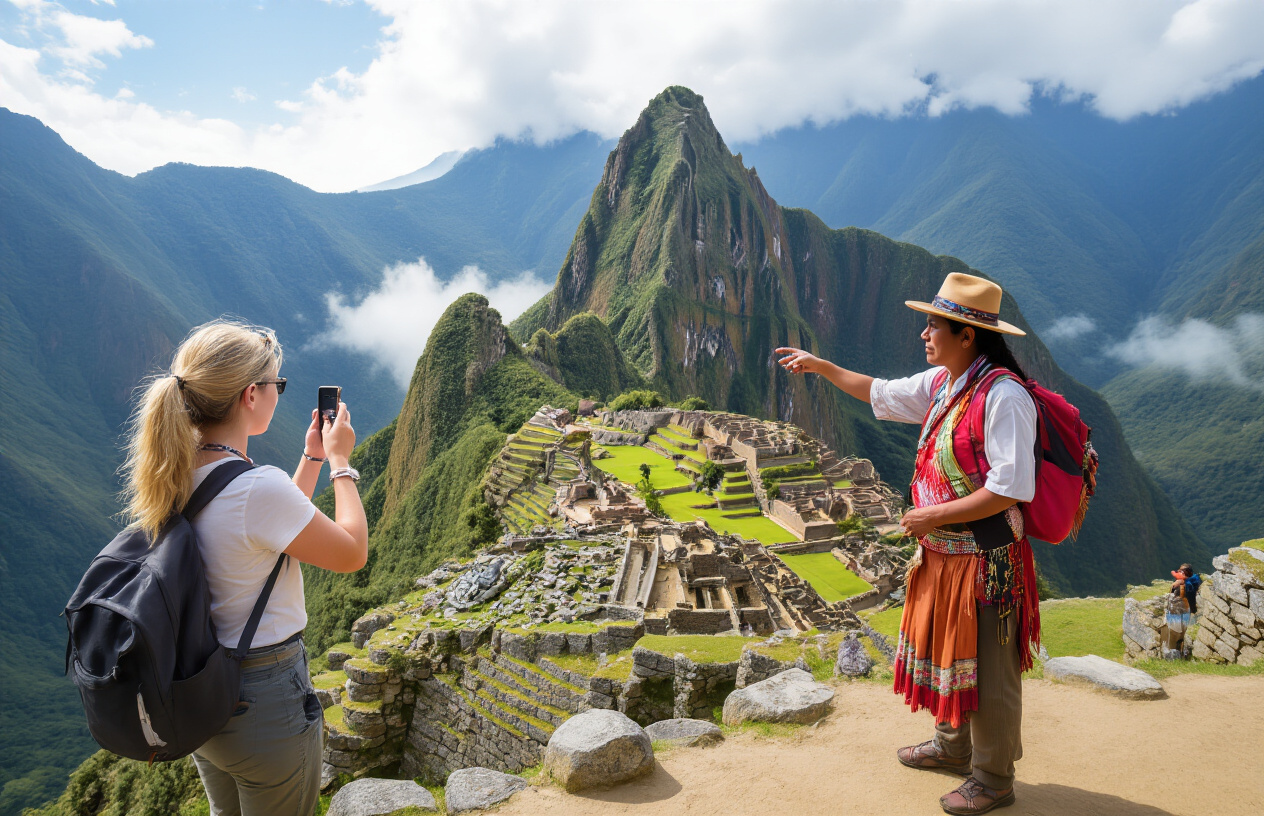
Local Cuisine Worth Trying
Ever tasted a proper Argentine empanada? It’s like a little pocket of heaven. South America’s food scene is just as impressive as its landmarks.
In Peru, ceviche isn’t just food—it’s practically religion. Fresh seafood “cooked” in lime juice with chili and cilantro. Locals eat it before noon when the fish is freshest.
Brazil’s feijoada might look like a simple black bean stew, but it’s a Saturday ritual bringing families together. Paired with caipirinha (Brazil’s national cocktail), you’ll understand why Brazilians are so passionate about their food.
Colombia’s arepas make the perfect breakfast—corn patties stuffed with cheese, meat, or eggs. Grab one from a street vendor for the authentic experience.
Festival Seasons to Enhance Your Visit
Timing your visit around festivals? Smart move.
Rio’s Carnival isn’t just a party—it’s THE party. Millions flood the streets for five days of samba, costumes, and pure joy. Book accommodations a year ahead or you’ll be sleeping on the beach.
Inti Raymi in Cusco celebrates the Incan sun god with a massive re-enactment featuring hundreds of performers in traditional dress. The colors alone are worth the trip.
Bolivia’s Diablada (Devil’s Dance) during Carnival transforms Oruro into a battlefield between good and evil, with dancers in the most elaborate masks you’ll ever see.
Interacting with Indigenous Communities Respectfully
The Amazon basin is home to hundreds of indigenous groups, each with their own language and traditions.
Before visiting any community:
- Ask permission to take photos
- Learn a few basic phrases in their language
- Dress modestly
- Bring small gifts like school supplies, not candy
In Ecuador’s Otavalo Market, buying directly from indigenous artisans supports families who’ve been weaving for generations.
Peru’s Sacred Valley communities welcome visitors but remember—their ceremonies aren’t tourist attractions. They’re living spiritual practices.
Shopping for Authentic Souvenirs and Crafts
Skip the airport gift shops. The real treasures are found in local markets.
Panama hats (ironically from Ecuador) are still hand-woven by artisans using techniques passed down for centuries. A quality hat takes weeks to complete.
Chilean lapis lazuli jewelry features that unmistakable deep blue stone found almost nowhere else on earth.
Argentine leather goods are ridiculously good. Their tanners are wizards with cowhide—get a belt or bag that’ll outlast anything in your closet.
Peruvian alpaca textiles? Softer than cashmere and way more interesting. Each region has distinct patterns telling stories of their cultural heritage.
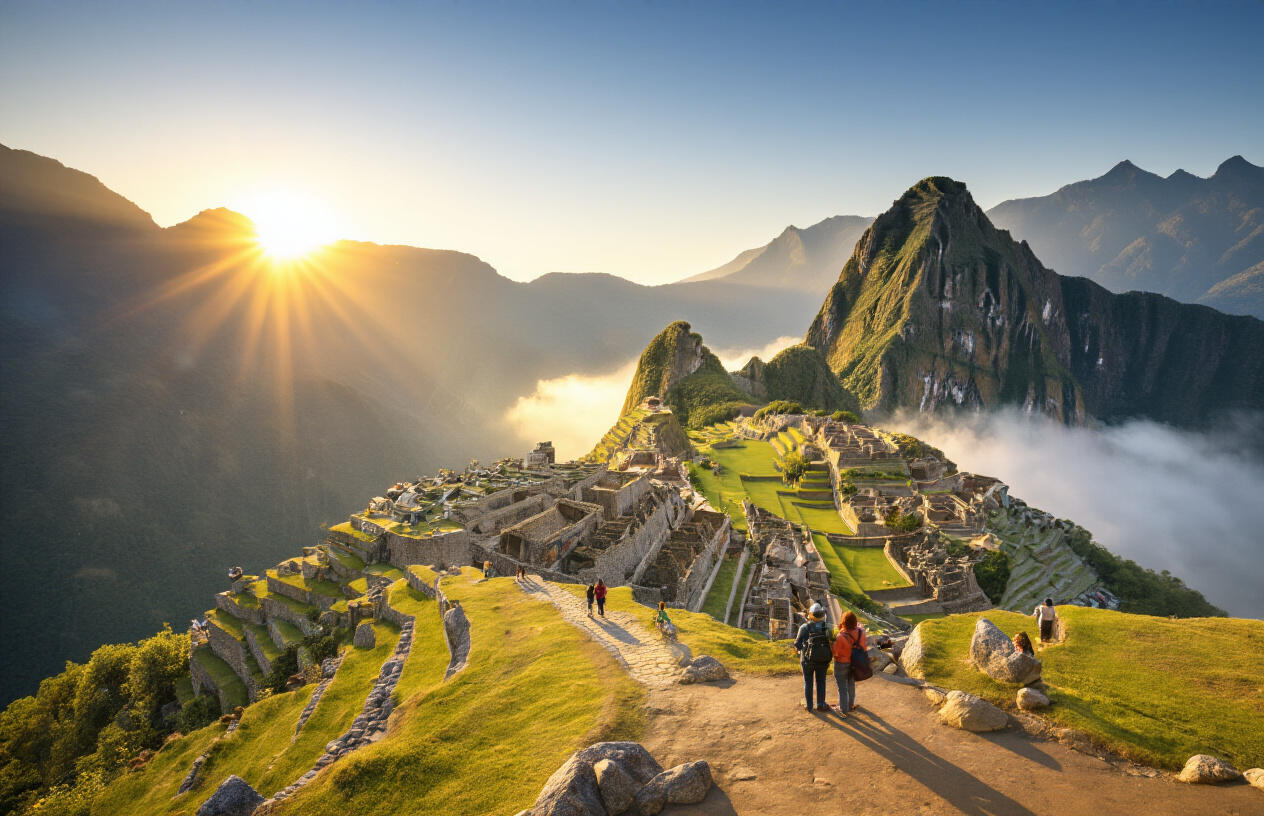
South America’s diverse tapestry of natural wonders and cultural landmarks offers travelers unforgettable experiences, with Machu Picchu standing tall as the continent’s most visited attraction. From the vibrant streets of Rio de Janeiro to the thundering waters of Iguazú Falls and the mysterious Amazon rainforest, each destination provides unique opportunities to connect with history, nature, and local traditions.
As you plan your South American adventure, consider a comprehensive tour that combines these incredible destinations. Whether you’re exploring ancient Incan ruins, dancing to samba rhythms, or marveling at natural wonders, South America’s top destinations promise memories that will last a lifetime. Pack your sense of adventure and immerse yourself in the rich tapestry of experiences this remarkable continent has to offer.

